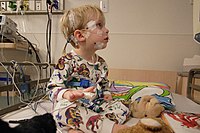
Photo from wikipedia
Acute sleep disturbances are a common, modifiable consequence of trauma that, if left untreated, increase risk of PTSD by nearly two-fold. This suggests acute sleep disturbances after trauma are an… Click to show full abstract
Acute sleep disturbances are a common, modifiable consequence of trauma that, if left untreated, increase risk of PTSD by nearly two-fold. This suggests acute sleep disturbances after trauma are an important contributor to the etiology of PTSD that could be targeted early to prevent the disorder. Yet, effective strategies to prevent PTSD cannot currently be implemented because we cannot identify who is most at risk of acute sleep disturbances after trauma, thus obstructing the ability to identify high-risk groups in need of early intervention. This study will test sleep reactivity – a trait predisposition to experience sleep disturbances after stress – as a predictor of posttraumatic sleep disturbances within one month following trauma exposure. We recruited patients admitted to Henry Ford Hospital’s intensive care unit in Detroit for traumatic injury (e.g., gunshot wound) (N = 88, M age = 39.53, SD = 14.31). While hospitalized, patients reported their pre-trauma sleep reactivity (Ford Insomnia Response to Stress Test; FIRST) and insomnia symptoms from the past two weeks (Insomnia Severity Index; ISI). Patients then completed the ISI again one month later (n = 48). We tested high sleep reactivity (FIRST > 21) as a prospective predictor of clinically significant posttraumatic sleep disturbances (ISI > 10). Patients were mostly black men (67%), and nearly half reported an annual income < $20,000 (47.7%). Motor vehicle collisions were the most common trauma that precipitated patients’ hospital admission (42%), followed by assaults with a weapon (30.7%). While adjusting for age and pre-trauma sleep disturbance, high sleep reactivity predicted increased odds of sleep disturbances one month after trauma (b = 2.08, SE = .98, p = .033, OR = 8.01, CI = 1.19 – 54.15). Individuals with high sleep reactivity are at increased susceptibility of clinically significant sleep disturbances after trauma. The 9-item FIRST is a brief and clinically useful indicator that offers providers the ability to predict the onset of acute sleep disturbances after trauma, which are novel targets for early intervention. This might enable the early identification of potentially vulnerable individuals who might develop PTSD, toward whom sleep-focused preventive efforts can be targeted.
Journal Title: SLEEP
Year Published: 2023
Link to full text (if available)
Share on Social Media: Sign Up to like & get
recommendations!